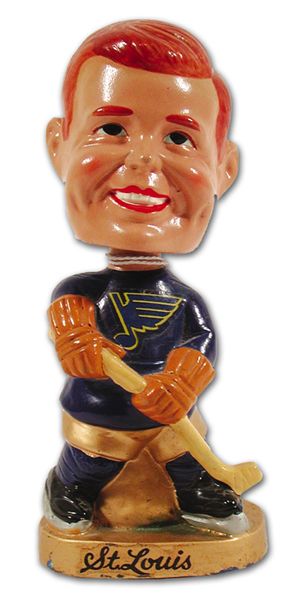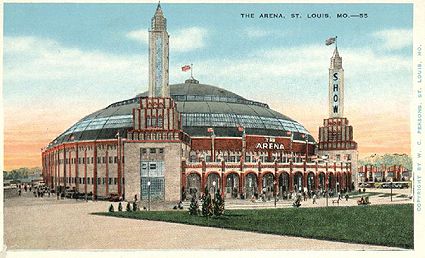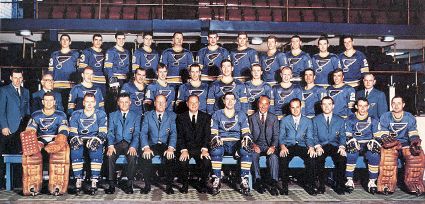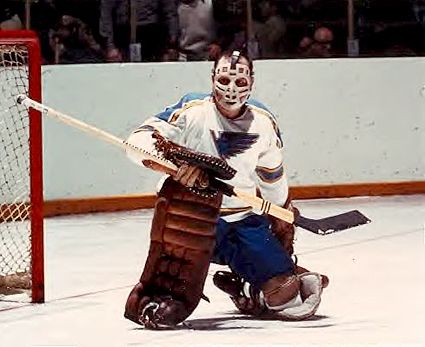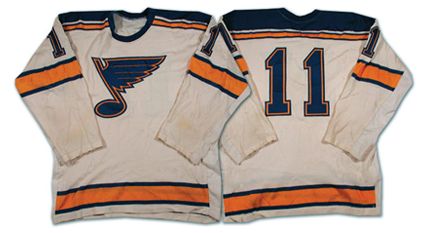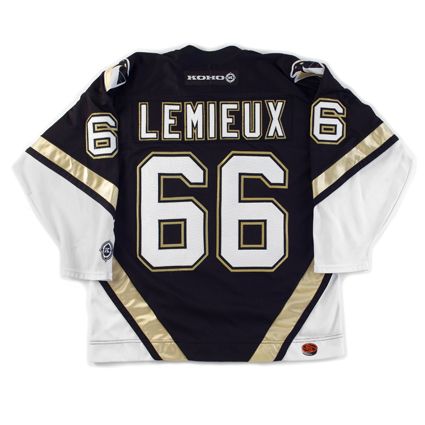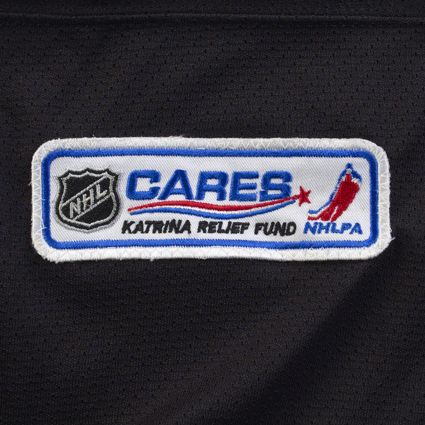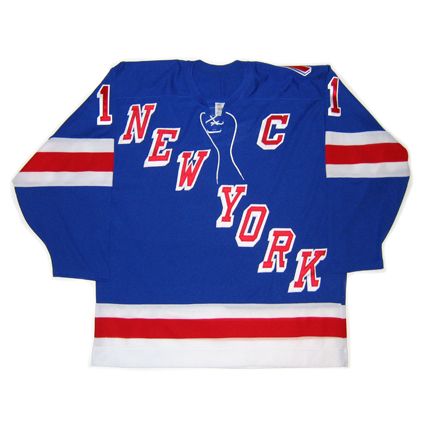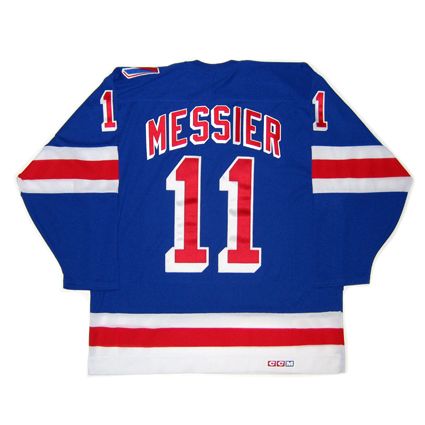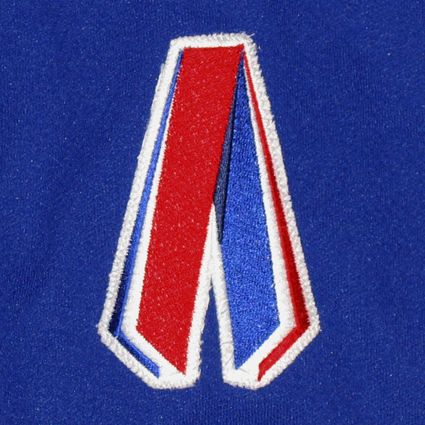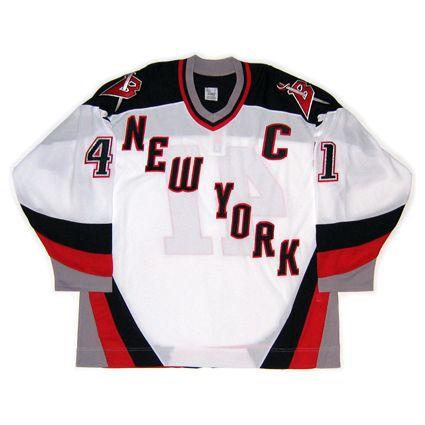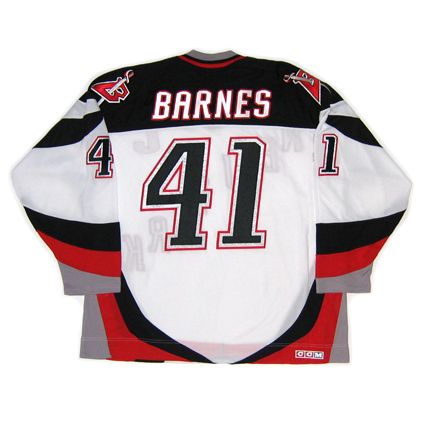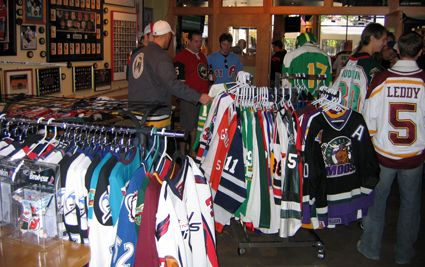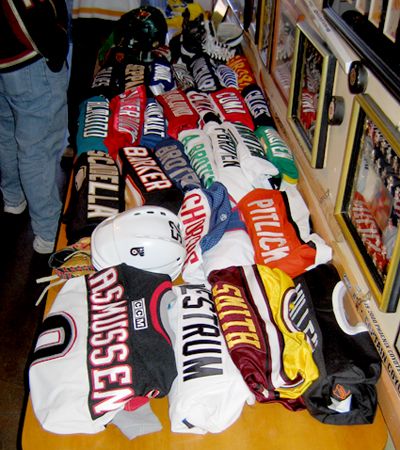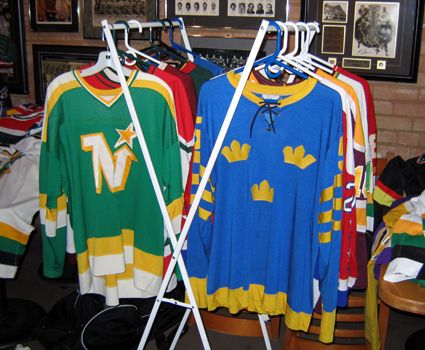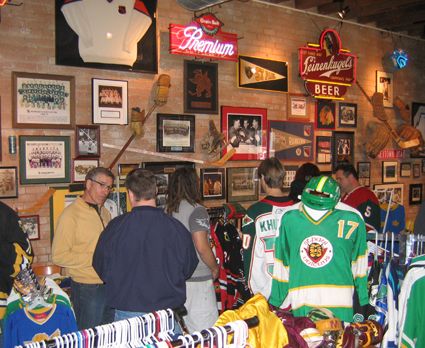Friday, October 11, 2013
1967-68 St. Louis Blues Gary Sabourin Jersey
Since the demise of the Brooklyn Americans in 1942, the NHL consisted of just six member teams, commonly referred to as "The Original Six". Finally, following the success of the Los Angeles Dodgers and San Francisco Giants of Major League Baseball on the west coast, the idea of expanding the NHL was first brought up in 1963, partly due to concerns that the Western Hockey League was intending to operate as a major league in the near future and also in hopes of making the league more attractive to American television networks with coast-to-coast appeal.
The original discussions promoted San Francisco and Vancouver as acceptable locations with Los Angeles and St. Louis also as potential candidates in March of 1965.
In February of 1966, applications were received from groups from Los Angeles, Pittsburgh, Minnesota, Philadelphia, San Francisco, Baltimore, Buffalo and Vancouver. But not St. Louis.
In the end, franchises were awarded to Oakland (across the bay from San Francisco), Los Angeles, Minnesota, Philadelphia, Pittsburgh and...
St. Louis!
The decision to exclude Vancouver caught many by surprise, especially those involved in the construction of the brand new Pacific Coliseum in Vancouver, and angered not only the locals, but all of Canada, since the six chosen cities were all in the United States. Various reasons emerged to explain the surprise inclusion of St. Louis, despite the fact there was no formal proposal from a group representing St. Louis.
Reportedly, the Toronto Maple Leafs and Montreal Canadiens did not want to share Canadian TV revenues with a third club and support for any expansion from the Chicago Black Hawks was contingent on the creation of a team in St. Louis, which would result in a near by rival as well as the sale of the run-down St. Louis Arena, which just conveniently happened to be owned by the Chicago Black Hawks ownership group at the time...
The St. Louis Arena
With the franchise now granted, the club's original owners spent several million dollars to massively renovate the arena, which included expanding it's capacity from 12,000 to 15,000 seats.
While Lynn Patrick was the original St. Louis Blues head coach, the legendary Scotty Bowman took over after a mere 16 games a roster which included veteran players Dickie Moore, leading scorer Red Berenson (51 points in 55 games after arriving in a trade) and goaltender Glenn Hall. While many of the players on the roster were NHL rookies or players with very limited NHL experience, they were not fresh-faced kids just out of juniors, but grizzled veterans with many seasons of minor league experience who were unable to crack the rosters of the Original 6 era, but who were more than capable of competing in the now 12 team NHL, some of whom would remain with the Blues for many seasons to come. Players such as Frank St. Marseille, Gary Sabourin, Barclay Plager, Noel Picard and Bob Plager.
The 1967-68 St. Louis Blues
That club would play the first game in franchise history on this date in 1967, when the Blues hosted their fellow expansion brothers the Minnesota North Stars at the arena in a game which ended in a 2-2 tie.
While the Blues had a rough early going, sinking to a 5-16-2 record, which included a 2-11 stretch in November and early December, the team came together following the coaching change to Bowman on November 20th. From December 9th to the end of January, the Blues reeled off a 13-5-6 run to climb to within 3 games of .500. Over the final two months of the campaign, the Blues won 9, lost 10 and tied 8 to finish the regular season with a 27-31-16 record for 70 points, just three back of the Philadelphia Flyers, and a spot in the playoffs.
As a way to allow the six new teams a chance to be competitive, or at least maintain the illusion of competitiveness for their fans, the six new clubs were placed together in the West Division, while the Original 6 teams comprised the East Division with the first two rounds of the playoffs conducted within one division, ensuring one of the new expansion teams a berth in the Stanley Cup finals.
The imbalance in the established clubs strength versus the six new teams was evident heading into the playoffs, as the fifth team in the East and first non-qualifyer for the playoffs, the Maple Leafs, had more points in the standings (76) than the all the teams in the West, led by Philadelphia's 73!
For whatever reason, the logic of the day dictated that the third place Blues drew the first place Flyers in the opening round, rather than the Flyers taking on the fourth place North Stars, as would be the case today. Regardless, the Blues, led by Hall's superb goaltending, shut out the Flyers at home in Game 1 by a score of 1-0. Philadelphia rebounded in Game 2 with a 4-3 win but St. Louis put the Flyers on the brink of elimination with 3-2 in overtime and 5-2 wins back at home.
The Flyers stayed alive with a dominant 6-1 back in Philadelphia and then forced a Game 7 when they defeated the Blues 2-1 in overtime in St. Louis. The Blues then eliminated the Flyers on the road 2-1 to advance to the semifinals where they would meet Minnesota.
That series would prove to be a knock-down, drag-out affair. The teams split the first two games in St. Louis, with the second one going to Minnesota in overtime. The North Stars took a 2-1 series lead before the Blues won the fourth game 4-3 in overtime to even the series at 2-2. St. Louis won 3-2 back at home in overtime followed by the North Stars holding serve at home in Game 6 by a score of 5-1. The deciding Game 7 was tied at 1-1 at the end of regulation before the Blues advanced to the Stanley Cup finals with the deciding goal at 22:50 of overtime, the fourth extra period of the seven game series.
Now forced to face the powerful Canadiens of the Original 6, the survivor of the East Division, the Blues acquitted themselves well, but fell in Game 1 3-2 in overtime and 1-0 at home before dropping Game 3 in overtime 4-3. Montreal then completed the sweep at home with a 3-2 win, bringing to an end the Blues exciting first season in the NHL. It would be the fourth game decided by a single goal thanks to the inspired play of Hall, who was praised by writer Red Burnett "A number of Hall's saves were seemingly impossible. Experts walked out of the Forum convinced no other goaltender had performed so brilliantly in a losing cause."
Today's featured jersey is a 1967-68 St. Louis Blues Gary Sabourin jersey from the Blues first season of play in the NHL. This first year Blues jersey is distinguished by the yellow waist and sleeve stripes, which would reverse colors for the playoffs and beyond.
Names were not worn on the backs of the white Blues jerseys until 1974-75. This original Blues style, albeit with the change in waist and sleeve stripes, would remain in use all the way through the 1983-84 season although the logo has stood the test of time and remains in use through today.
Today's video section begins with highlights of the 1968 Stanley Cup finals, set to some hip tunes probably better suited to surfing highlights.
Next is a better song, the one which inspired the club's name, the St Louis Blues sung by Bessie Smith.
Labels:
Hall Glenn,
St. Louis Blues
Wednesday, October 9, 2013
2005-06 Pittsburgh Penguins Mario Lemieux Jersey
On this date in 2005, Mario Lemieux suited up for the final home opener of his NHL career.
Being a part owner of the Penguins as of September 1, 1999 Lemieux realized that the Penguins greatest asset was - himself. He returned to the ice on December 27, 2000 and proceeded to score a goal and a pair of assists in his first game back. During the 43 games he played during the remainder of the 2000-01 season, Lemieux scored 76 points, the highest points-per-game average of any player that season, and led the Penguins to the conference finals.
The 2001-02 season saw Lemieux appear in only 24 games after his season was cut short due to chronic hip injuries aggravated while captaining Canada to the gold medal in the Olympics held in Salt Lake City. He would play in just a single game following the Olympics.
The following season would see Lemieux manage to play in 67 games and total 91 points, leading the scoring race for much of the year before missing most of the games near the end of the schedule and the Penguins would miss the playoffs for the second year in a row.
He would only play but ten NHL games in 2003-04, with just a single goal to his credit. That fall he would make his final appearances for Team Canada, captaining the squad that captured the championship in the 2004 World Cup of Hockey. He would score a goal and four assists in six games played.
After the lockout season of 2004-05, he would return to the ice for the start of the 2005-06 season and skate along side Sidney Crosby for 26 games at age 40, before finally calling it a career on January 24, 2006. He would score 22 points in 26 games that season, but felt he could no longer compete at the level he was accustomed to in the past.
Today's featured jersey is a 2005-06 Pittsburgh Penguins Mario Lemeiux jersey as worn in the home opener of his final season as an NHL player. The jersey features the NHL Cares/Katrina Relief Fund patch worn during the first period of each NHL team's first home game of the season.
The patched jerseys were then auctioned off to raise money to aid the victims of Hurricane Katrina, which devastated New Orleans, Louisiana in August of 2005. Lemeiux's game worn jersey generated the third highest final price league-wide with a final bid of $6,710 behind rookies Crosby ($21,010) and Alexander Ovechkin ($7,929). Overall the auction of 600 jerseys raised over a half a million dollars, which was then matched by the Garth Brooks' Teammates for Kids Foundation.
Here is the beginning of Lemieux's second return from retirement on December 27, 2000 after becoming owner of the Penguins.
This video shows Mario Lemieux's final goal of his career after being high sticked earlier in the video along with a rare Ziggy Palffy sighting in a Penguins jersey, as he would retire mid-season along with Lemieux.
Labels:
Lemieux,
Pittsburgh Penguins
Monday, October 7, 2013
2001-02 New York Rangers "New York" Mark Messier Jersey
On this date in 2001, the Buffalo Sabres travelled to Manhattan to take on the New York Rangers in the Rangers emotional home opener at Madison Square Garden, the first Rangers home game following the terrorist attacks on the World Trade Center less than a month earlier.
Further making this game unique was that both the Sabres and Rangers wore special jerseys that evening with the regular team cresting replaced with "NEW YORK" diagonally across the chest.
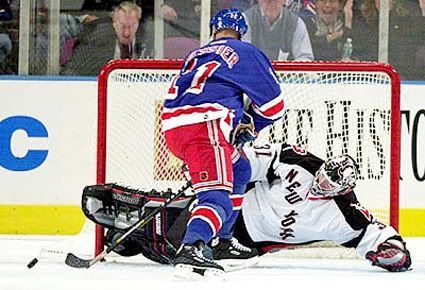
Today's featured jersey is a 2001-02 New York Rangers "New York" Mark Messier jersey. This jersey features Messier's captain's "C" as well as the special "New York" cresting, which replaced the normal "Rangers" wordmark for this one game only. In addition, this jersey is completed with the 9/11 memorial ribbon patch on the left shoulder, which was worn by the Rangers for the entire 2001-02 season.
To create this special jersey, a blank Rangers CCM was first purchased and a 9/11 memorial ribbon patch purchased on ebay. The jersey was then sent in for customizing, with not only Messier's name and number, but also the addition of the special "New York" cresting recreated in the same font as a standard Rangers jersey. The project was then completed with the 9/11 memorial ribbon patch.
While at first glance it appears to be a standard Rangers jersey, sharp-eyed expert viewers will be rewarded by noticing the alternate "New York" cresting.
Bonus jersey: Today's bonus jersey is a 2001-02 Buffalo Sabres "New York" Stu Barnes jersey. This jersey features Barnes' captain's "C" as well as the special "New York" cresting, which replaced the normal Sabres logo for this one game only.
Further making this game unique was that both the Sabres and Rangers wore special jerseys that evening with the regular team cresting replaced with "NEW YORK" diagonally across the chest.

The special jerseys were worn for just that one contest and auctioned off afterwards to raise money for The Twin Towers Fund to aid victims of the terrorist attacks.
The game was played after a moving pre-game ceremony that honored the men and women in uniform who died trying to save lives in the World Trade Center attack as the New York Police Department and Fire Department of New York hockey teams lined up on the ice and the Rangers skated between them during their introductions.
FDNY team member Larry McGee had brought Ray Downey's firefighters helmet with him with a picture of Downey tucked into the brim of the helmet. He noticed that of all the players, only Rangers captain Mark Messier had not worn his hockey helmet during the pre-game ceremonies.
FDNY team member Larry McGee had brought Ray Downey's firefighters helmet with him with a picture of Downey tucked into the brim of the helmet. He noticed that of all the players, only Rangers captain Mark Messier had not worn his hockey helmet during the pre-game ceremonies.
As the Rangers were lined up at the blueline, McGee sensed the moment was right and skated over to Messier with the helmet and told him it would be an honor if he would wear it. Messier responded, "Sure, whatever you need" and donned the helmet of the still missing Downey as the Madison Square Garden crowd roared it's approval.
Mark Messier wearing Chief Downey's helmet prior to the Rangers first home game following the 9/11 terrorist attacks. Note the special "New York" jersey worn only for that game.
"For me, personally, it was very emotional for a lot of reasons," said Messier, "Obviously, with all the people being honored - the firefighters, the police, the rescue workers, the volunteers, the entire city - and all our fans. All on a day when we started fighting back as a country."
Once the game began, the Rangers Eric Lindros opened the scoring at 8:13 of the first period on the power play in his first game at Madison Square Garden and J. P. Dumont evened the score for Buffalo a little over a minute later at 9:38.
Stu Barnes was credited with the Sabres second goal at just 1:59 of the second and Vaclav Varada stretched the Sabres lead to 3-1 at 14:46. The Rangers struck back late in the second with a pair of goals in the final minute to send the game into the third period even at 3-3 when Michal Grosek put one in at 19:12 and Andreas Johansson got the Rangers third with just a tick of the clock remaining at 19:59.
The Rangers too their first lead of the night at 3:11 of the third when Radek Dvorak beat the Sabres Bob Essensa on a breakaway but Slava Kozlov tied the game once more at 4:58 when he beat Rangers goalie Mike Richter.
Brian Leetch would win the game for the Rangers with a slapshot with 2:15 remaining in the overtime to give the Rangers a come-from-behind win in their home opener on a dramatic evening.
At the conclusion of the auction, the highest bids received were $20,010 for Mark Messier's Rangers jersey, $15,010 each for Richter and Leetch's of the Rangers, $9030 for Theo Fleury's Rangers jersey and $8030 for Lindros of the Rangers with the highest Sabres jersey being Barnes at $5885. In total, 44 jerseys were auctioned off and over $215,000 was raised.
Today's featured jersey is a 2001-02 New York Rangers "New York" Mark Messier jersey. This jersey features Messier's captain's "C" as well as the special "New York" cresting, which replaced the normal "Rangers" wordmark for this one game only. In addition, this jersey is completed with the 9/11 memorial ribbon patch on the left shoulder, which was worn by the Rangers for the entire 2001-02 season.
To create this special jersey, a blank Rangers CCM was first purchased and a 9/11 memorial ribbon patch purchased on ebay. The jersey was then sent in for customizing, with not only Messier's name and number, but also the addition of the special "New York" cresting recreated in the same font as a standard Rangers jersey. The project was then completed with the 9/11 memorial ribbon patch.
While at first glance it appears to be a standard Rangers jersey, sharp-eyed expert viewers will be rewarded by noticing the alternate "New York" cresting.
Bonus jersey: Today's bonus jersey is a 2001-02 Buffalo Sabres "New York" Stu Barnes jersey. This jersey features Barnes' captain's "C" as well as the special "New York" cresting, which replaced the normal Sabres logo for this one game only.
Similar to the Rangers jersey, a blank Sabres CCM was first purchased. After locating the proper Sabres shoulder patches on ebay, the jersey was then sent in for customizing, with not only Barnes name and number, but the "New York" cresting recreated in the same font as the Sabres names on the back.
Unlike the more subtle change from "Rangers" to "New York" in the same font in today's featured jersey, this Sabres jersey replaces their usual buffalo head logo with the diagonal "New York" lettering, making this particular jersey stand out more from the usual Sabres jerseys of the day.
Unlike the more subtle change from "Rangers" to "New York" in the same font in today's featured jersey, this Sabres jersey replaces their usual buffalo head logo with the diagonal "New York" lettering, making this particular jersey stand out more from the usual Sabres jerseys of the day.
In today's video section, here is a brawl from the October 7th, 2001 game when the Sabres and Rangers wore their special "New York" jerseys. You can see the Sabres jersey at the start before the players tie up. The 9/11 memorial ribbon patch can clearly be seen on the Rangers player's shoulder during the fight and you do get a clear look at both fighters jerseys at the end of the video when the fight is broken up and they are leaving the ice.
Plus, any day we get to post a video featuring Sabres announcer Rick Jeanneret is a good day.
Just because we can, some more Jeanneret excitedly calling a few goals by Barnes in the way only he can.
Finally, Messier recalls his memories of 9/11.
Labels:
9/11,
Barnes Stu,
Buffalo Sabres,
Messier Mark,
New York Rangers
Sunday, October 6, 2013
The Minnesota Hockey Collectors Expo at Tom Reid's Hockey City Pub
Today, Sunday, October 6th is one of the highlights of the collecting calendar. Anyone in the Twin Cities of Minneapolis and St. Paul should stop by Tom Reid's Hockey City Pub near the Xcel Energy Center for the annual Minnesota Hockey Collectors Expo from 10 AM to 6 PM.
It's the largest gathering of game worn jerseys in Minnesota each year and you can count on seeing some amazing and varied collections in a great hockey environment. This event is free and features collectors bringing favorites from their personal collection for some good old show and tell, with an emphasis on jerseys related to the Minnesota Wild, Minnesota North Stars and Minnesota Gophers, as well as many other interesting jerseys from throughout the hockey world. It's great opportunity to see some great game worn jerseys up close, meet some knowledgeable hockey fans and perhaps add a new jersey to your collection.
In addition to the jersey collectors, you can count on several former players, such as past Minnesota North Stars Brad Maxwell, Tom Younghans and Gordie Roberts being in attendance, with all three expected to attend this year as well as a few other announced guests, highlighted by Stanley Cup Champion Tom Chorske.
To further entice you to attend, here are some photos from previous gaherings.
Above is the impressive Ben Clymer collection on the left and Kyle Oen's Minnesota themed collection on the right. Collecting one player, such as Clymer can be a challenge when they make multiple stops in the NHL and AHL, but that challenge increases exponentially when a player extends his career by playing in Europe, so this collection was all the more impressive with the addition of game worn jerseys from the German DEL.
Kyle brought a sampling of his game worn Minnesota high school jersey collection that rivals the one on display at the Xcel Energy Center, as well as other Minnesota based teams.
Above is John Lindberg's take on a Minnesota theme. Where Kyle collects teams from Minnesota, John is more about former Gophers NHL jerseys as well as Minnesota Wild prospects jerseys worn before they reach the NHL.
Can't make it to the Hockey Hall of Fame in Toronto? Then having the opportunity to see Jon Bakke's amazing collection of vintage jerseys with an international flavor can save you the trip. That's not just an old Sweden jersey either, it's Borje Salming's jersey! John can easily be spotted at Minnesota Wild games wearing his rotating collection of gamers, as he doesn't just hang them in a closet, he wears his regularly to Wild games.
Here are two more collections, which come at the hobby from different directions. Chris Groth (hanging on the left) just collects what catches his eye, although with a Minnesota influence, such as Mikko Koivu's game worn retro Finland jersey worn for one game of the 2008 World Championship, but his Alexander Ovechkin game worn jersey was certainly an Expo highlight.
The collection folded on the the table on the right was a very interesting collection of vintage NHL jerseys, mainly the 1980's and 1990's, from our favorite period of NHL jerseys and were terrific to look at and talk about.
Here was our contribution to the proceedings, closer to the camera were our jerseys worn in the movie "Miracle" and our game worn international jerseys from places such as East Germany, Holland, Iceland, Japan, Poland and even Spain as well as the more traditional countries like Canada, the Czech Republic and Russia. We also brought our Minnesota Twins baseball gamers on the far side of the rack.
The walls of Tom Reid's are just dripping with hockey memorabilia and create the perfect environment to hold such an event.
Finally, the event organizer Dave Frechette, without whom the Expo would not exist. Dave's collection focuses primarily on Minnesota Wild players jerseys, primarily before they joined the Wild, or at least non-Wild jerseys. Examples in his collection are Wild prospects college and junior team jerseys, European born players European club teams, Wild coaches sweaters from their NHL playing days, Wild players previous NHL team's jerseys and Wild players jerseys worn when they played for their national teams, such as Mikko Koivu's Team Finland jerseys.
How he is consistently able to track down jerseys from such a wide variety of sources is one of the more impressive things to take in at the Expo. He also has an appreciation of hockey history, as evidenced by the rare and wonderful Minnesota Fighting Saints WHA jersey seen here as well as his North Stars game worn jersey he is wearing.
We certainly hope those of you in the area will take the time to attend this can't miss event!
Labels:
Minnesota Hockey Collectors Expo
Subscribe to:
Comments (Atom)

